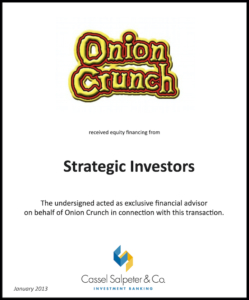Don’t let economic uncertainty prevent business decisions for 2013
To view original article click here.
Despite concerns, things are actually looking pretty good for the middle-market, but there are issues to keep in mind.
BY JAMES CASSEL JCASSEL@CASSELSALPETER.COM
Forget sugar plums. The visions dancing in the heads of South Florida’s middle-market business owners this holiday are looming recessions, cliffs and general uncertainty for the New Year. With this skeptical outlook, they’ve been holding off on major moves, including capital spending and hiring, until they’re certain the government is likely to chart an effective plan for strong, sustainable growth – or at least provide some rules so everyone knows how to play the game.
From afar, the world now can look pretty topsy-turvy. Europe is tangled in debt, and China is troubled with slowing growth, an expanding housing bubble and unreliable data. Here in the U.S., Capitol Hill has been debating plans on how to stave off controversial tax hikes and budget cuts known as the fiscal cliff, and although compromise seems to be in the air, the abundance of speculation and the scarcity of facts are keeping most people feeling uneasy.
However, from a different vantage point closer to ground level, things are actually looking pretty good for the middle-market in 2013. Here are some of the reasons we can feel optimistic as we move into the New Year:
Jobs are making a comeback: Despite the uncertainty, some middle-market business owners are hiring and expanding. National unemployment is well below its 10 percent peak, and the National Association for Business Economics estimates that by next year, the economy should be adding 173,000 jobs a month, up from 157,000 this year.
The latest Labor Department report shows the economy is picking up a bit, with employers adding 146,000 jobs in November – more than expected – and the unemployment rate dropping two-tenths of a percentage point to 7.7 percent.
Consumer debt has been shrinking: Consumers have been deleveraging and paying off their debts. Consumer confidence, which continues to rise, is as high as it was in 2007 before the crisis.
Housing is making a comeback: Demand is expected to increase as the Fed keeps buying bonds so mortgage rates remain at historically low rates. In addition, more construction means more jobs, and more people spending more money to furnish their new homes and enhance their lifestyles. In fact, the latest buzz in South Florida is: The extinct “tower crane” makes a comeback.
While many middle-market business owners will likely remain in their current wait-and-see mode until they have more clarity and confidence about the future, they should recognize that not making major business decisions is a major business decision, and there can be significant costs to missing opportunities. Therefore, it’s critical to consider how your business may be impacted by the expected new developments in 2013, and work with trusted advisors to develop a plan of action that’s custom-tailored to fit your business needs. Toward that end, here are a few key things to look out for in 2013:
Recession: Experts are debating whether there will be a recession, and some experts are warning of a mild one. If we go over the cliff, it is more likely to occur. Therefore, now is the time to consider how a recession could impact your business and work with your advisors to prepare your business for this possibility. Whether we go into another recession, it is always good to keep your company lean in terms of implementing sound inventory controls and weeding out bad, unprofitable customers. Cultivate relationships with your good customers to help minimize the possibility of losing business. Invest in hiring employees, not firing them. Now is a good time to look for good workers who have been laid off by other companies. Also, avoid the instinct to cut your marketing expenses, which could make things worse. Continue spreading the word about your business and, just as important, stay positive and look for ways to bring in new customers. Look at additional products to sell and other markets to enter.
• China: How will China’s economic issues affect your business? With an increase in production costs, even companies in China will start looking for lower-cost producers. Should you consider moving production back to the U.S. (what I like to call “re-shoring”). The cost of labor is becoming less of an issue than getting products on time, and having lower shipping costs can help off-set that.
• Government business: Look at how much business you are doing with the Federal Government, the Defense Department, etc. It is difficult to imagine that there will not be spending reductions at the federal level irrespective of what happens. Some people think that as states begin to recover and receive increased tax revenue, there will be more opportunities to do business with state and local governments. There is much pent-up demand for matters that have been deferred during the past few years.
• Loans: Despite today’s low interest rates, middle-market business owners have continued to sit on their cash reserves rather than deploying the cash or borrowing to make investments while keeping their cash safe for other purposes.
Unless they are extremely confident about an opportunity, they are not likely to invest. However, it’s important to keep in mind that U.S. banking regulators are likely to begin implementing higher standards for reserves. Although they make the banking system safer by providing greater cushions for banks against market fluctuations, they may make it more difficult for banks to lend money. So, if you’re considering getting a loan, you might want to secure your loan before the new standards go into effect.
There’s no doubt that middle-market business owners are in much better financial shape today than they were back during the credit crisis. By planning ahead, consulting their advisors, positioning their businesses correctly and, just as important, adopting the right perspective, middle-market business owners can stand to benefit greatly from emerging opportunities in the New Year.
James Cassel is co-founder and chairman of Cassel Salpeter & Co., LLC, an investment-banking firm with headquarters in Miami that works with middle-market companies.www.casselsalpeter.com




